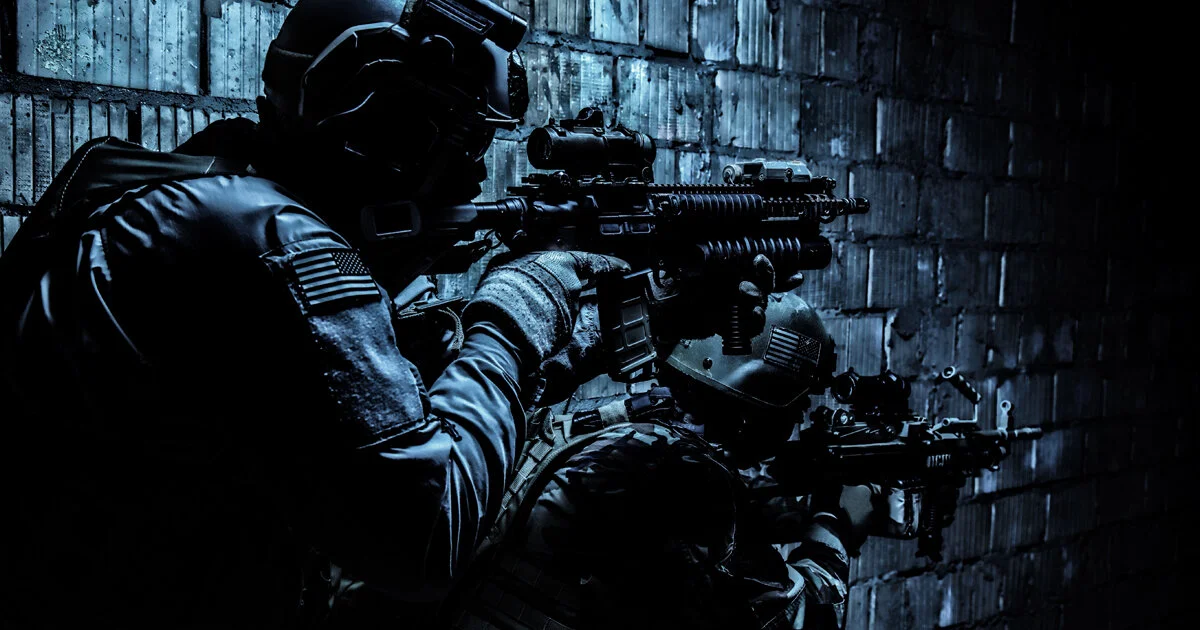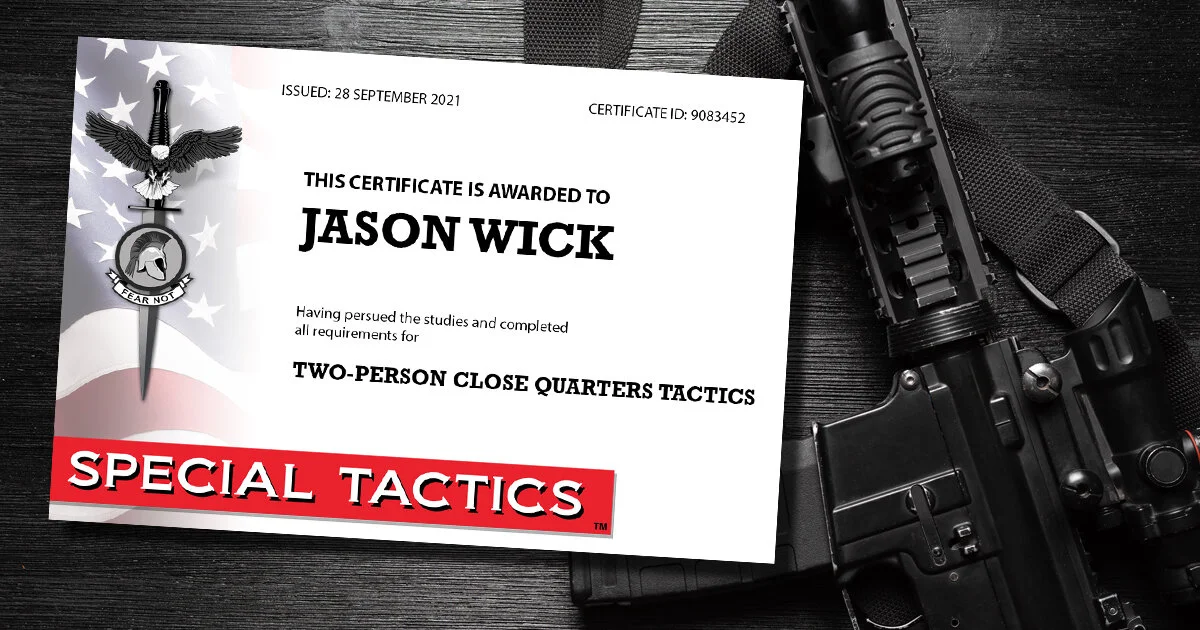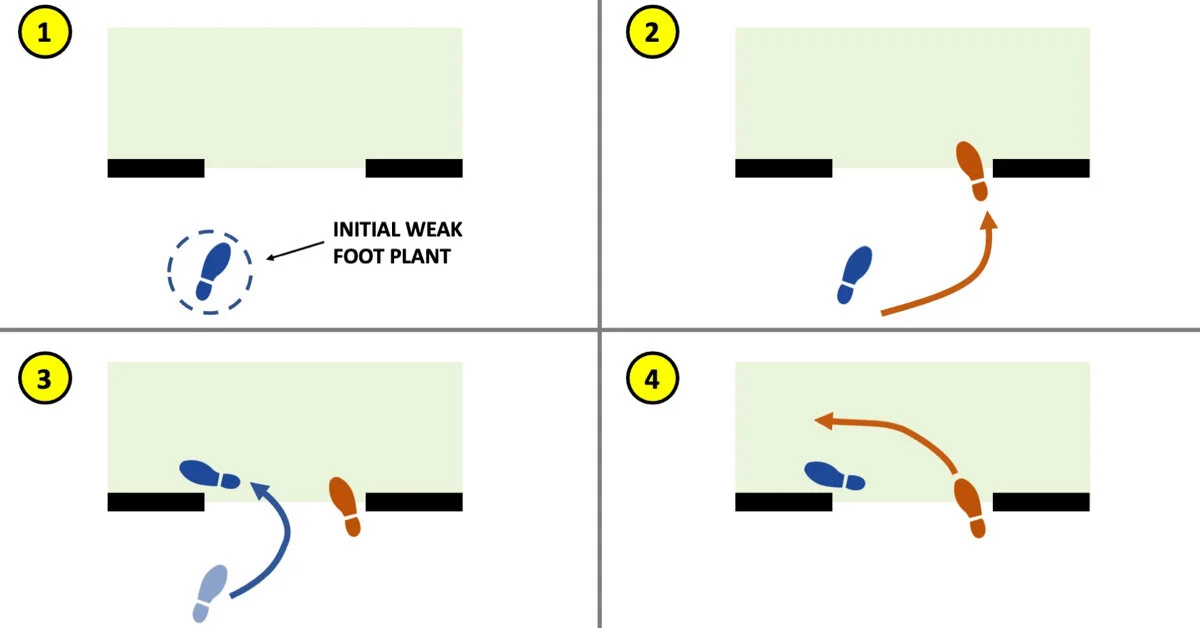Our new High-Intensity Military Urban Combat book is an abridged version of the longer Squad-Level Military Urban Combat manual published by Special Tactics in 2017 which required controlled distribution and could not be published digitally because it contained sensitive but unclassified information regarding U.S. military urban warfare tactics. This version has extracted two sections from the original manual that contain no sensitive information, making this abridged version suitable for international, digital distribution. The core value provided by this new manual is a focus on the often neglected subject of high-intensity conventional warfare. Such tactics and knowledge could prove particularly useful for allied military forces as conventional conflicts grow more common around the world.
All in Close Quarters Battle
Advanced Room Clearing for Close Protection
Our latest book focuses on room clearing tactics (RCT) as they apply to VIP protection work. The book is the first volume in Special Tactics’ new advanced series. The term “advanced” does not necessarily mean that the techniques themselves are more advanced. The book still focuses on basics and fundamentals but instead of covering individual techniques, it focuses on providing more real-world, scenario-based examples of how to combine various techniques to solve tactical problems.
Tactical Home Defense: Neighborhood Security
Our latest book goes into detail on a wide range of topics relating to home defense and security while providing examples of effective tactics and techniques that can help you protect yourself and your family. This article takes a few passages and diagrams from the sections on alert plans, neighborhood security and response. The full book goes into more detail on this topic also and covers personal response and law-enforcement response to a home invasion.
Tactical Home Defense: Defensive Positioning
Our latest book goes into detail on a wide range of topics relating to home defense and security while providing examples of effective tactics and techniques that can help you protect yourself and your family. This article takes a few sections and diagrams from the chapter on armed defensive techniques. The full book goes into more detail on this topic and covers many other topics including community defense planning, threat assessment, improvised weapons and security systems.
Two-Person CQB: Fighting Outside of Buildings (Part 2)
If you have to move through an urban environment where threats could emerge from any building or direction, you must be prepared to move tactically in the safest way possible. Urban movement tactics are particularly useful for dealing with terrorist attacks or active shooter (deadly attacker) scenarios. The last installment in this two-part article focused on cover and concealment. This second part focuses on crossing alleys and streets.
Two-Person CQB: Fighting Outside of Buildings (Part 1)
If you have to move through an urban environment where threats could emerge from any building or direction, you must be prepared to move tactically in the safest way possible. Urban movement tactics are particularly useful for dealing with terrorist attacks or active shooter (deadly attacker) scenarios. This short article is taken from our Two-Person CQB Online Course and companion book. It provides a brief discussion of how to move and fight in the street or in-between buildings in an urban environment.
Two-Person CQB: Training for the Fight
Training is particularly important for two-person operations. Not only do you need to know how to perform various techniques yourself, but you and your partner need to know how to work as a team and coordinate your actions in a safe manner. Whenever you are operating as a team with more than one person, there is a significant risk of friendly fire. Effective training, practice and rehearsals offer the best way to avoid friendly fire accidents.
Singleton CQB: Shallow Entry Technique (Part 2 of 2)
The shallow entry techniques (sometimes called “limited penetration” techniques) are designed to prevent you from becoming over-committed or trapped deep in a target room. In single-person operations, it is often better to stay closer to a door so you can quickly move through it to avoid threats coming from either direction. This short article is taken from our Single-Person CQB Online Course and companion book. It provides step-by-step instructions for conducting the shallow entry technique. We will explain this technique in two articles. This article explains the second half of the technique.
Singleton CQB: Shallow Entry Technique (Part 1 of 2)
The shallow entry techniques (sometimes called “limited penetration” techniques) are designed to prevent you from becoming over-committed or trapped deep in a target room. In single-person operations, it is often better to stay closer to a door so you can quickly move through it to avoid threats coming from either direction. This short article is taken from our Single-Person CQB Online Course and companion book. It provides step-by-step instructions for conducting the shallow entry technique. We will explain this technique in two articles. This article explains the first half of the technique.
Singleton CQB: Active Shooter and Sniper Response
Unfortunately, deadly attacker (active shooter) situations are becoming more and more common. Most deadly attackers are perpetrating acts of terrorism, are very committed, ready to die and seek to cause maximum death and destruction. This short article is taken from our Single-Person CQB Online Course and companion book. It provides a brief discussion of how to employ the principles of Single-Person CQB tactics when faced with an active shooter (deadly attacker) or sniper attack.
How is Singleton CQB Different from Team Operations?
Single-person (Singleton) CQB tactics are different from tactics developed for teams and multiple teams. The reason for this is the increased risk associated with operating alone. Even if you are very experienced in team-level operations, it may still take time for you to master the specific skills and movements needed for single-person operations. This short article is taken from the introduction to our Single-Person CQB Online Course and companion book. It provides a brief discussion of how CQB tactics change when you are operating alone.
Singleton CQB to Counter a Home Invasion
Since launching our new in-person training initiative we have received some requests to cover single-person (singleton) and two-person close quarters battle (CQB) techniques in a home invasion scenario. The article below is a partial extract from our Single-Person CQB course which is now live on the Tactics Society online academy. We recommend our single-person and two-person CQB courses for any gun owners who want to better protect their homes.
Join Us for Live, In-Person Training
For the first time, Special Tactics is honored to offer live, in-person training courses for civilians, law-enforcement officers and military personnel provided by senior special operations veterans from Tier-1 Special Missions Units. We will be publishing more articles on our training philosophy and innovative training methods in the days and weeks to come.
Get Certified at our New Online Academy
After many months of work and transition our new online academy is now live through our partnered organization, The Tactics Society. The new online academy is easier to use, more streamlined and offers serial-numbered, printable PDF certificates for the completion of each course.
Advanced CQB Equipment 1: Assault Kit Introduction
There are no “right answers” when it comes to equipment setup. The most important thing is finding a setup that is effective for you and what works for one person might not work for another. However, it can be helpful to share general ideas and principles or specific tips/techniques when it comes to equipment setup since equipment configuration is a never-ending process and there is always a way to make your kit layout function a bit better. This first article in the Advanced CQB Equipment series covers some of the most basic concepts and ideas relating to kit layout.
Advanced CQB Footwork 3: Limited Penetration Footwork
Limited penetration techniques (or what we refer to as “shallow entry”) have a number of applications. In the most general terms, the purpose of executing a shallow entry as opposed to a deep entry is to minimize your exposure to danger areas deeper in the room and to remain closer to the entry door, making it easier for you to pull back or break contact in an emergency. Shallow entry techniques are more common and widespread than many people realize. For example, when a four-person team executes a traditional “points of domination” room entry technique, the third and fourth person into the room are actually executing a shallow entry (limited penetration) movement to compliment the deep entry executed by the first two assaulters. Therefore, learning the correct footwork for shallow entry can be useful regardless of which CQB system you employ.
Advanced CQB Training 1: How to Train Footwork
It is one thing to learn or understand new footwork techniques. It is another to be able to apply those techniques effectively in a high-stress situation. Mastering footwork requires a great deal of practice and as we mentioned earlier, it is not just about the quantity of practice. The quality of practice is even more important. This article covers some practice/training techniques for refining and optimizing your CQB footwork.
Advanced CQB Footwork 1: Turn Right, Turn Left
One of the most fundamental CQB movements is moving through a doorway and turning to either the right or left to clear the corner. This article does not claim to offer the only way to clear a corner, but rather aims to offer a series of concepts and options to help each individual or team refine their own techniques to a more advanced level.
Advanced CQB Part 1: What is "Advanced" CQB?
In the coming weeks and months, Special Tactics will be releasing a series of articles, online courses and books covering the topic of “Advanced Close Quarters Battle.” This first article is a primer to understand what Advanced CQB is and what it is not. In our opinion, advanced CQB is not about learning new advanced techniques but rather about mastering the basic techniques to an advanced level.
Military Urban Combat Now Shipping
After many delays, the Squad Level Military Urban Combat book is now shipping. The manual is over 400-pages long and provides a wide selection of common sense concepts and tactical options, designed to help military units develop their own mission-specific tactics, techniques and SOPs (Standard Operating Procedures) for both low-intensity urban operations (COIN and stability operations) and high-intensity conventional urban warfare.




















